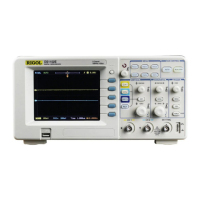
Do you have a question about the Rigol DS1102E and is the answer not in the manual?
| Bandwidth | 100 MHz |
|---|---|
| Sample Rate | 1 GSa/s |
| Channels | 2 |
| Memory Depth | 1 Mpts |
| Vertical Sensitivity | 2 mV/div to 10 V/div |
| Trigger Modes | Edge, Pulse, Video, Slope, Alternate |
| Vertical Resolution | 8 bits |
| Input Coupling | DC, AC, GND |
| Power Supply | 100-240 V AC, 45-440 Hz |
| Display | 5.7 inch TFT LCD |
| Display Resolution | 320 x 234 |
| Interfaces | USB Host, USB Device |
| Input Impedance | 1 MΩ ±2%, 15 pF ±3 pF |
| Dimensions | 303 mm x 154 mm x 133 mm |
Familiarization with the front and rear panels, buttons, and interface elements.
Explanation of vertical controls, knobs, and status bar for waveform display.
Explanation of horizontal controls, knobs, and status bar for time base settings.
Explanation of trigger controls, knobs, and status bar for signal triggering.
Details on configuring channel coupling, bandwidth, probe attenuation, and filters.
How to adjust time base, position, Delayed Scan, and display modes (Y-T, X-Y, Roll).
Guide to configuring trigger modes, sources, slope, sweep, and trigger setup.
How to use automatic measurement features for voltage and time parameters.
Using manual, track, and auto modes for cursor-based measurements.
Addresses issues like no display, missing waveform, incorrect measurements, unstable display, and slow refresh.
Trigger sensitivity, level range, offset, holdoff, and trigger mode specifications.